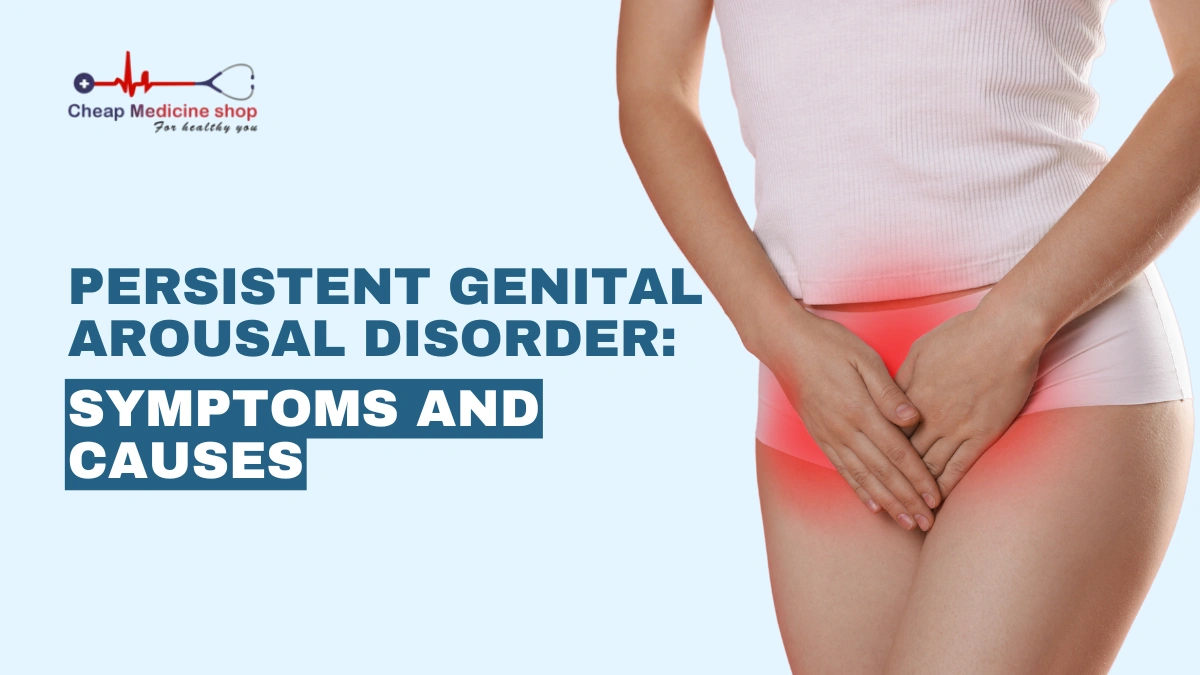Sexual health is a very personal and sensitive topic. While many conditions related to sexual function are widely discussed, others remain in the shadows due to stigma, misunderstanding, or lack of awareness.
One such problem is Persistent Genital Arousal Disorder (PGAD). Despite being rarely spoken about, PGAD can impact the lives of those affected by it. This condition involves unwanted, continuous feelings of genital arousal that are not because of sexual desire or thoughts.
It can cause both physical discomfort and psychological distress, making it important to recognize, understand, and address appropriately. This article aims to explain PGAD in simple, clear terms to promote awareness and reduce the isolation often experienced by those suffering from it.
What is Persistent Genital Arousal Disorder (PGAD)?
PGAD, is a condition where a person experiences ongoing or recurrent feelings of sexual arousal such as tingling, throbbing, swelling, or pressure in the genital area, without any sexual desire.
These sensations can last for hours or even days and may occur frequently throughout the day. Importantly, these feelings are not caused by sexual stimulation or thoughts, and even if orgasm occurs, the symptoms often continue.
PGAD is not the same as Hypersexuality, where a person may have frequent sexual thoughts or urges. Instead, people with PGAD feel physically aroused against their will, which can be both confusing and distressing.
Save up to 90% on your medicine bills

Your Happy Shilajit Gummies

Kapiva Shilajit Gold Resin

Leeford Shilajit Tablets

Carmel Organics Ashwagandha Extract Tablets
Symptoms of PGAD
The symptoms of PGAD can vary from person to person, but often include:
- Persistent feelings of genital arousal such as throbbing, tingling, pulsing, or pressure
- Genital sensitivity or fullness, even without sexual thoughts
- Little or no relief after orgasm
- Discomfort or pain due to prolonged arousal
- Episodes that are triggered by non-sexual activities, such as sitting, driving, or vibrations
- Emotional distress, including Anxiety, Depression, and feelings of shame or guilt
Who can get PGAD?
PGAD most commonly affects women, especially those going through hormonal changes such as Menopause, but it can also affect men and people of all genders. It may develop suddenly or gradually and can occur at any age, though it is more frequently reported in adults.
Since PGAD is not well understood, many people who experience it do not seek help immediately. They may feel embarrassed or think they are the only one going through it.
What causes PGAD?
There is no single known cause of PGAD. However, it may be linked to a combination of physical, neurological, hormonal, and psychological factors. Some possible causes include:
- Nerve issues: PGAD may be related to nerve irritation or compression, especially in the pelvic area. For example, problems with the pudendal nerve, which supplies the genitals, can lead to abnormal sensations.
- Pelvic Floor Dysfunction: Tight or spasming pelvic floor muscles may contribute to persistent feelings of arousal. These muscles help in sexual function and bladder control.
- Hormonal changes: Some people develop PGAD during Perimenopause or Menopause, possibly due to changes in estrogen levels. Hormonal medications, like antidepressants or hormone replacement therapy, may also play a role.
- Medication use or withdrawal: Certain medications, especially Selective Serotonin Reuptake Inhibitors (SSRIs), may trigger PGAD symptoms or make them worse, either during use or after stopping the medication.
- Cysts or growths: Conditions like Tarlov cysts, which are fluid-filled sacs that form on the nerves near the spine, have been linked to PGAD. These cysts may press on nerves involved in genital sensation.
- Psychological factors: Stress, Anxiety, and unresolved trauma may worsen symptoms. However, PGAD is not a psychological disorder, though mental health can affect how symptoms are experienced.
Impact on mental health
The emotional toll of PGAD can be severe. Many people feel embarrassed, ashamed, or afraid to speak up. The symptoms may interfere with relationships, sleep, work, and self-esteem.
Common mental health issues include:
- Anxiety
- Depression
- Irritability
- Social withdrawal
- Relationship difficulties
Addressing mental health is an important part of treating PGAD. No one should have to suffer in silence.
Diagnosis: How is PGAD Identified?
Since PGAD is a rare and often misunderstood condition, diagnosis can be difficult. There is no single test for PGAD. Instead, healthcare providers use a combination of patient history, diagnostic tests and physical exams to rule out other possible conditions.
The following steps may be involved:
- Detailed history of symptoms and their impact on life.
- Pelvic examination to check for muscle tension or nerve pain.
- Neurological evaluation, including imaging like Magnetic Resonance Imaging (MRI), to check for nerve damage or cysts.
- Hormone tests, especially if symptoms started during Menopause.
- Psychological assessment, if emotional distress is high.
Unfortunately, many people are misdiagnosed or not taken seriously. Awareness among healthcare professionals is growing, but not all doctors are familiar with PGAD. Finding a specialist in pelvic health or sexual medicine can make a significant difference.
Persistent Genital Arousal Disorder treatment
There is currently no single cure for PGAD, but many people find relief through a combination of treatments. The approach depends on the cause and may involve both physical and mental health care.
Medications
Certain medications may help reduce symptoms, such as:
- Nerve pain medications like Gabapentin or Pregabalin
- Antidepressants, especially tricyclics, in low doses
- Hormonal therapies, if symptoms are related to Menopause
It’s important to consult a doctor before starting or stopping any medication.
Pelvic floor physical therapy
This is one of the most effective treatments for PGAD. A specialized therapist can teach relaxation exercises, stretching, and biofeedback techniques to release tension in the pelvic muscles and reduce arousal sensations.
Nerve blocks
In cases where nerve irritation is suspected, pudendal nerve blocks or spinal injections may help relieve symptoms.
Cognitive Behavioral Therapy (CBT)
CBT can help people cope with the distress and anxiety caused by PGAD. It does not cure the physical symptoms but can reduce emotional suffering and improve quality of life.
Support groups and counseling
Talking to others who experience PGAD can be healing. Support groups, whether online or in person, can offer validation, tips, and encouragement.
Coping strategies for daily life
Living with PGAD can be overwhelming, but you can manage the condition and improve daily functioning. Some coping strategies include:
- Using cold packs or topical numbing agents to ease sensations.
- Wearing loose, comfortable clothing to reduce friction.
- Avoiding activities that trigger symptoms, such as long periods of sitting.
- Practicing deep breathing or meditation.
- Keeping a symptom diary to identify patterns and possible triggers.
- Communicating openly with doctors and loved ones.
Conclusion
Persistent Genital Arousal Disorder (PGAD) is a rare but impactful condition characterized by ongoing, unwanted genital arousal without sexual desire. While its exact cause can vary from nerve dysfunction and pelvic floor issues to hormonal changes and medicine effects, PGAD is a medical condition that requires thorough evaluation and a treatment plan.
Management involves a combination of approaches, including pelvic floor therapy, medicines for nerve or hormonal balance, cognitive behavioral therapy, and lifestyle modifications.
Identifying triggers, working with specialists familiar with pelvic health or sexual medicine, and addressing coexisting mental health concerns are all essential parts of care. Because PGAD is not widely understood, many people face delays in diagnosis and treatment. Increased awareness among both the public and doctors is needed to improve outcomes.

Frequently Asked Questions
Can PGAD be linked to other medical conditions?
Yes, PGAD has been observed alongside conditions like Restless Leg Syndrome (RLS), overactive bladder, Vulvodynia, and interstitial cystitis. Some researchers suggest there may be a neurological connection between these disorders, especially where nerve sensitivity or dysfunction is involved.
Does PGAD affect sleep quality?
Yes, many people with PGAD report disrupted sleep due to persistent sensations or discomfort. Nighttime arousal episodes can interfere with falling asleep or staying asleep, leading to fatigue, irritability, and worsening of mental health symptoms.
Can certain foods or lifestyle factors worsen PGAD symptoms?
Some individuals report that caffeine, alcohol, or spicy foods may intensify symptoms, though evidence is anecdotal. Maintaining a balanced diet, staying hydrated, and reducing stimulants may help manage symptom flares in some cases.
Can PGAD go away on its own?
Yes, in some cases, PGAD symptoms may reduce over time, especially if they were caused by a specific trigger like medication withdrawal or hormonal shifts. However, for many people, symptoms persist and require treatment. Early medical help improves the chances of managing it effectively.
Is PGAD a sexually transmitted condition?
No, PGAD is not caused by a sexually transmitted infection (STI) and is not contagious. It is linked to internal nerve, hormone, or muscle function, and it does not spread from person to person through sexual contact.
Cheap Medicine Shop only refers to credible, authoritative sources for our content. If you’re curious about how we ensure the integrity of our content, we encourage you to read our Content Information Policy.














